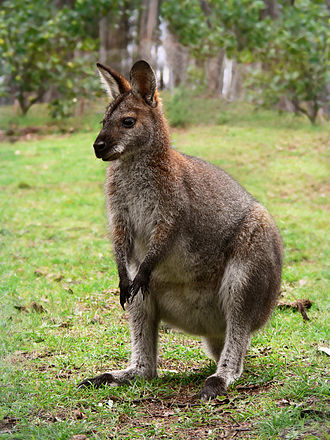- Wallabies are marsupials that belong to the same family as kangaroos and are native to Australia and surrounding islands.
- There are over 30 different species of wallabies, ranging in size from small to medium.
- Wallabies are herbivorous animals and primarily feed on grass, leaves, and other plant matter.
- They have a unique reproductive system where the female has a pouch in which she carries and nurses her young, called joeys.
- Wallabies are known for their powerful hind legs, which enable them to hop with great speed and agility.
- They have a keen sense of hearing and can rotate their ears independently to detect sounds from different directions.
- Wallabies have adapted to a variety of habitats, including forests, grasslands, and rocky areas.
- Some wallaby species, like the agile wallaby, are excellent climbers and can scale trees and rocky cliffs.
- They have a specialized stomach with multiple compartments to aid in the digestion of plant material.
- Wallabies have strong teeth and jaws, allowing them to efficiently chew tough vegetation.
- They are predominantly nocturnal, being more active during the night and resting during the day.
- Wallabies have a well-developed sense of smell, which they use to locate food sources and detect potential predators.
- They are social animals and often form small groups called mobs or troops.
- Wallabies use their long, muscular tails for balance while hopping and as a prop when sitting or resting.
- They have sharp claws on their front feet, which they use for grooming and digging for food.
- Wallabies have a natural camouflage that helps them blend into their surroundings and avoid detection by predators.
- They can reach speeds of up to 30 miles per hour (48 kilometers per hour) while hopping.
- Wallabies have a lifespan of around 9 to 15 years in the wild, depending on the species.
- They communicate with each other through a variety of vocalizations, including grunts, barks, and hisses.
- Wallabies are territorial animals and use scent marking to establish and defend their territories.
- Some wallaby species, like the red-necked wallaby, have the ability to swim across bodies of water.
- They have a strong maternal instinct, and female wallabies are known to be highly protective of their young.
- Wallabies have been introduced to other parts of the world, including New Zealand, where they have become established populations.
- They are excellent jumpers and can clear distances of up to 3 meters (10 feet) in a single bound.
- Wallabies have a unique hopping gait, where they use both hind legs simultaneously, followed by both front legs.
- They are known to exhibit courtship rituals that involve displays of agility and strength, such as boxing matches between males.
- Wallabies have a specialized adaptation called diapause, where the development of the embryo is delayed until favorable conditions for survival are present.
- They have a high metabolic rate, allowing them to efficiently convert food into energy for their active lifestyle.
- Wallabies have a strong sense of balance, which is crucial for their hopping and maneuvering in various terrains.
- They can withstand extreme temperatures, both hot and cold, by seeking shade or huddling together for warmth.
- Wallabies have adapted to arid environments and can obtain most of their water requirements from the vegetation they consume.
- They have a flexible neck that allows them to rotate their heads in different directions to scan their surroundings.
- Wallabies have large, expressive eyes that provide them with good vision, particularly in low-light conditions.
- They have a thick fur coat that helps regulate body temperature and provides insulation during colder months.
- Wallabies have been featured in Indigenous Australian culture and artwork, representing resilience, survival, and connection to the land.
- They have been observed engaging in grooming behaviors, where they use their front paws to clean their fur and remove parasites.
- Wallabies have a unique adaptation called heterodont dentition, where they have different types of teeth specialized for different functions, including cutting, tearing, and grinding.
- They are agile and can quickly change direction while hopping to evade predators.
- Wallabies have a relatively small head in proportion to their body size, with a broad muzzle and large ears.
- They have been studied for their unique adaptations, including their ability to conserve water and navigate in different terrains.
- Wallabies play an important ecological role by contributing to seed dispersal and vegetation control through their feeding habits.
- They have a specialized system of tendons and ligaments in their legs that stores and releases elastic energy during hopping, allowing them to conserve energy while moving.
- Wallabies are curious animals and have been observed investigating objects and their surroundings with their noses and paws.
- They have a sensitive sense of touch, particularly in their snouts and feet, which helps them navigate their environment.
- Wallabies are resilient and adaptable animals, capable of surviving in diverse habitats and environmental conditions.
- They are known for their graceful movements and elegant postures, capturing the attention and admiration of observers.
- Wallabies have been featured in wildlife conservation efforts, as some species face threats due to habitat loss and human activities.
- They have a unique digestive system that allows them to extract maximum nutrition from the plant material they consume.
- Wallabies have been a subject of scientific research, contributing to our understanding of marsupial biology, reproduction, and evolution.
- They are fascinating and charismatic creatures, representing the unique biodiversity of Australia and captivating the imaginations of people around the world.
Facebook Comments


































